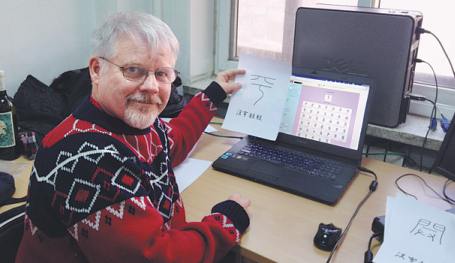Visitors to Tianjin Museum in early December were delighted to meet Richard Sears, the popular researcher of Chinese characters, nicknamed "Uncle Hanzi".
A group of Yueyang Road Primary School students were happy to talk with the US researcher during their visit to an exhibition to commemorate the 120th anniversary of the discovery of the oracle bone characters, on Dec 7.
Sears, 69, shared his knowledge, including the origin of meng, or dream, and the insights and sources of the Chinese characters found on many of the exhibits, with the students.
Sears is the founder of hanziyuan.net, an online resource for studying and learning the etymology of Chinese characters, the first website of its kind.
He is renowned in China for his self-sponsored study of Chinese characters. In 2012, he sold his house in the US and moved to China to intensify his research.
His first port of call was Tianjin, before moving to other cities including Beijing and Nanjing-all of which have, at some point in the nation's history, served as the Chinese capital.
Garnering nationwide praise, the website contained Sears' research of up to 31,000 characters etched on oracle bones, in excess of 24,000 found on bronzeware and more than 11,000 characters engraved on seals. Additionally there is the study of over 38,000 characters found in the Liushutong, which was published in the Yuan Dynasty (1271-1368), and documented "the rules of six types of Chinese characters" in calligraphy.
New focus
In a dialogue with researchers and local journalists, Sears said he is currently researching the connections between Chinese characters and science and has been building a scientific outlook toward the characters.
"I have deconstructed up to 15,000 Chinese characters into 960-1,000 different parts," he explains. "And from the parts, I'm trying to trace every character's story and development path.
"Many of the characters are associated with astronomy, some are even intertwined with the knowledge of textile processing," he says.
His assistant notes that Sears, who now lives in the suburbs of Nanjing, the capital of East China's Jiangsu province, frequently visited the Yunjin Museum, which showcases Yun Brocade-a type of fabric with a history dating back to 417-to verify his assumptions and research on certain characters and their connection with the ancient Chinese textile making process.
"Because I majored in physics, I have a profound interest in the scientific meaning of Chinese characters, many theories of which are proven to be true and many of which need to be further verified," he says.
Oracle bone character
Since oracle bone characters are among the world's earliest examples of a written language system and are the roots of Chinese culture and its characters, Sears has devoted much of his effort to studying them.
Qian Ling, deputy curator of Tianjin Museum, revealed some of the history of oracle bone studies in Tianjin during a dialogue with Sears.
"It was widely known that the oracle bones were unearthed in Central China's Henan province, but few people knew that the first researcher who discovered the value of the oracle bones was Wang Xiang from Tianjin," she says.
Sears noted the bones' connection with Tianjin through its research heritage is hardly a coincidence, because the city's rich history and rapid commercial development in the early 20th century laid the foundation for that research.
Qian said the world's archaeology and character research circles have shown an increasing interest in the oracle bone characters and Sears is a prime example.
During the event, Sears shared some of his research results pertaining to simplified Chinese, things even many ordinary Chinese people might not know.
Qian verified Sears' understanding and lauded it as being "of great significance".
Local researchers and educators agreed with some of his comments, including his criticism of erroneous explanations of the origins of Chinese characters he witnessed during visits to some local primary schools, which inspired his scientific study of the ancient characters.
Sears' efforts were appreciated by many locals.
He apparently paid less than 2,000 yuan ($284) a month for his rented Tianjin apartment in 2012, and he is believed to be enjoying a favorable rate for his current apartment in Nanjing.
His willingness to self-finance his research struck a chord with some local Chinese entrepreneurs, and a number of them donated money and resources so that he can continue his efforts. Contact the writer at

